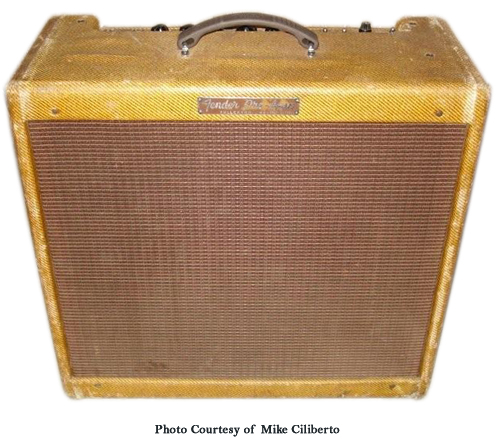Fender Narrow Panel Tweed Pro
Model/Circuit Number: 5E5 (55), 5E5-A (56-60)
Years of Production: 1955-1960
Era: Narrow Panel
Configuration: Combo
Controls: Chrome top facing w/ white screened labels, controls numbered 1-12
Knobs: Black Chicken Head
Faceplate
- Front: 5E5: Ground Sw, Fuse (3A), Power Sw, Standby Sw, Pilot Lamp, Tone, Vol, Mic Vol, In, In, Mic In, Mic In 5E5-A: Ground Sw, Fuse (3A), Power Sw, Standby Sw, Pilot Lamp, Presence, Bass, Treb, Vol, Mic Vol, In, In, Mic In, Mic In
- Rear:
Cabinet
- Dimensions: 20” x 22” x 10”
- Hardware: Leather Handle(1955-58), Brown Dogbone (1959-1960)
- Handle: Flat Leather Handle
- Feet: Nail in Feet
- Corners: None
Covering Material
- Tolex/Tweed: Diagonal tweed
- Grill Cloth: Oxblood with Stripe
Logo: Cabinet mounted, Script
Weight:
Speaker
- Size: 1×15”
- Impedance: 8 ohms
- Model: Jensen P15N(For more info, check out the Jensen Replacement Speakers)
Effects: None
~Watts: 35-40 Watts
Tubes
- Pre amp: 5E5: Mic: 12AY7, Instrument: 12AY7, ½ 12AX7 shared by both channels 5E5-A: Mic: ½ 12AY7, Instrument: ½ 12AY7, 12AY7 and ½ 12AX7 shared by both channels Phase Inverter: ½ 12AX7 (split load)
- Power: 2 x 6L6GB or 5881 (58-60)
Bias: 5E5: Cathode biased 5E5-A: Fixed bias, nonadjustable
Rectifier: 5U4GA
Comments: * Model 5E5 had the negative feedback loop is removed. * Model 5E5-A returned the negative feedback loop with the addition of the Presence control. * A selenium rectifier is used in model 5E5-A’s bias circuit.


I have a 59 Tweed Pro with the Tung-Sol brown base 5881s from the factory. They are the original power tubes as well as the 5U4GB rectifier and preamps.These later models called for just one 12AY7 in V1. You can use a 12AX7 for more gain.The 59 was the best year with the big Jensen P15N and 5881s in my opinion. They use the same power transformer as the tweed Bassman. They are rated at 26 watts not 35-40 as stated above.They shared the same chassis and circuit as the tweed Super and tweed Bandmaster but with different output transformers of course.The 59 Pro has the 8 ohm Triad 45217 output and the Triad 8087 power transformer. The earlier tweed Pros used the 6516 power trans and 1846 output.These are great amps and you don’t know your playing through a 15″ speaker. They really push some air but are not too bassy.The P15N can handle the 26+ watts easily and break up around 6-7 on the volume control.The 5E5-A is the best model and discontinued in 1960 and replaced with the brown Pro with solid state rectifier and yes 40+ watts on these.Alot more headroom and a much different sound.The final version was the 63-65 blackface Pro and went back to a tube rectifier using the great GZ-34 Mullard. They were rated around 30+ watts. Of all the 15″ Pros the late tweeds from 58-60 are just an awesome amp.No tremolo like the brown and blackface ones just in your face narly tone….Mark K.
I have a clone built by a Indiana builder. Jone’s Amplification. It’s all hand wired and an
Absolute tone monster. Not sure about the specs but I believe it’s about 35 watts and is plenty loud. This amp has an added presence control and a master volume. 6L6s and
2 Mojotone 10″ speakers.
I have a ’55 5E5-A on the bench.
It weighs 40 pounds. I noticed this was missing from the page.
In other news …
The tube chart is a “Model 5E5” tube chart stamped “EL” (1955 December), so it just squeaked in to 1955.
The serial number (in the low 300’s) on the chart matches the chassis’s serial number.
According to http://superiormusic.com/page195.htm the serial number places this Pro in the earlier half of the serial number range used by Fender in 1955 (S00100 to S00800), so the tube chart date and serial number disagree significantly with Superior’s date range data.
The newest original filter cap is dated 526 (26th week of ’55). The oldest filter cap is dated 1952.
The pots are dated 1955, the 41st week.
The original speaker is missing.
I have a ‘56 and it sounds fantastic. Got it locally from the grandson of the original owner who gigged it in the 50s and 60s. The 40 watts is accurate.